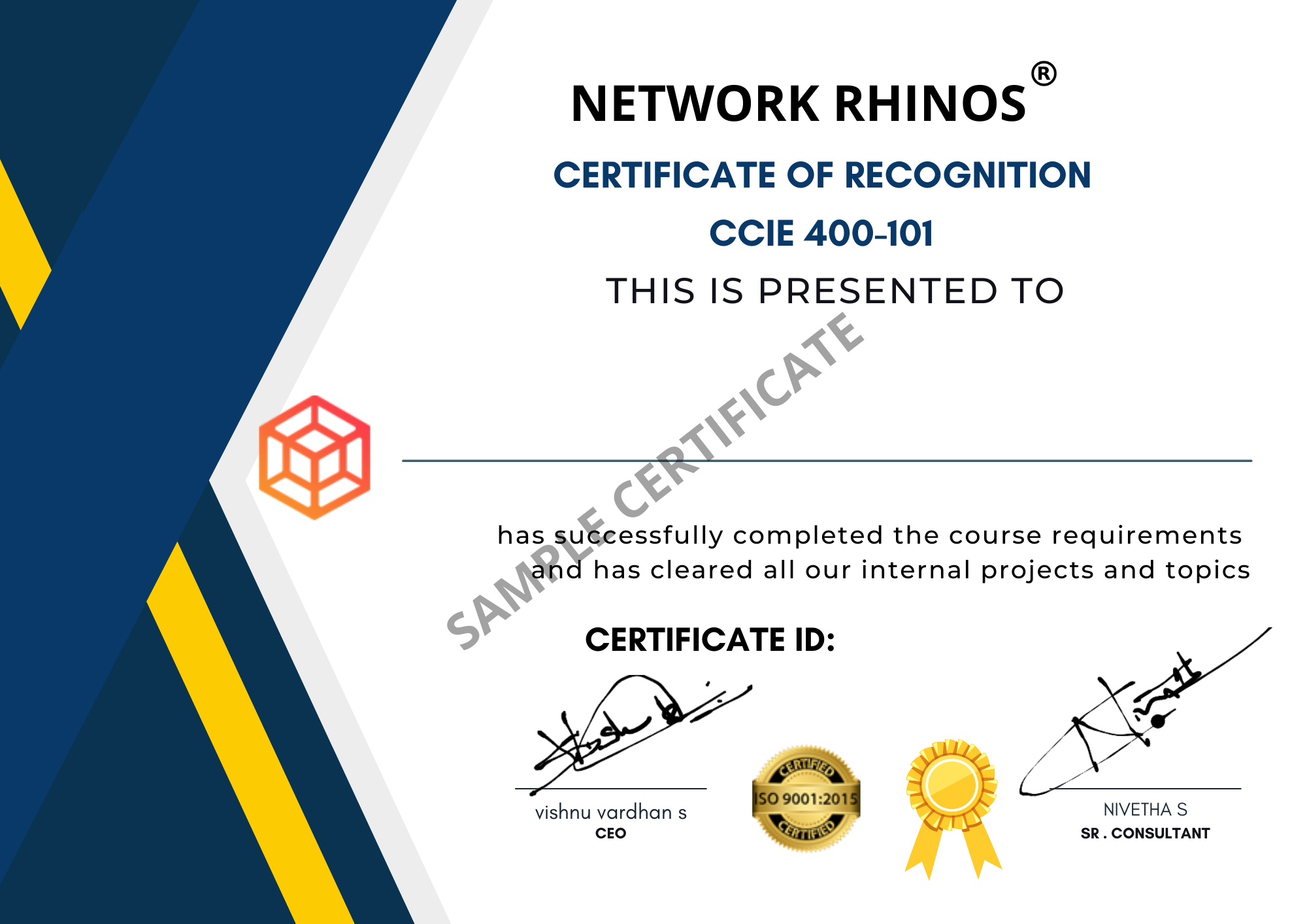About CCIE Course
The CCIE course will teach you everything you need to know about networking and network design. You will start with the fundamentals of networking and gradually move towards advanced topics like routing, switching, security, and data centers. By the end of this course, you will be confident in solving networking problems and managing large-scale networks.

Flexible batches for you
Why Study With Us?
Experienced Instructors
Learn from experts who simplify complex topics.
Hands-On Projects
Build real projects to create a strong portfolio.
Flexible Learning
Study at your own pace with on-demand video lessons.
Job-Ready Skills
Gain practical skills and certifications for better job opportunities.
Learn Anytime, Anywhere
Study anytime, anywhere, at your own speed.
CCIE Course Benefits
Tools & Technologies Covered
Course Curriculum
- 1.2.a Administrative distance
- 1.2.b VRF-lite
- 1.2.c Static routing
- 1.2.d Policy Based Routing
- 1.2.e VRF aware routing with any routing protocol
- 1.2.f Route filtering with any routing protocol
- 1.2.g Manual summarization with any routing protocol
- 1.2.h Redistribution between any pair of routing protocols
- 1.2.i Routing protocol authentication
- 1.2.j Bidirectional Forwarding Detection
- 1.5.a IBGP and EBGP peer relationships
- i Peer-group/update-group, template
- ii Active, passive
- iii Timers
- iv Dynamic neighbors
- v 4-bytes AS numbers
- vi Private AS
- 1.5.b Path selection
- 1.5.c Routing policies
- i Attribute manipulation
- ii Conditional advertisement
- iii Outbound Route Filtering
- iv Standard and extended communities
- v Multi-homing
- 1.5.d AS path manipulations
- 1.5.e Convergence and scalability
- 1.5.f Other BGP features
- 2.1.a Design a Cisco SD Access solution
- i Underlay network (IS-IS, manual/PnP)
- ii Overlay fabric design (LISP, VXLAN, Cisco TrustSec)
- iii Fabric domains (single-site and multi-site using SD-WAN transit)
- 2.1.b Cisco SD Access deployment
- i Cisco DNA Center device discovery and device management
- ii Add fabric node devices to an existing fabric
- iii Host onboarding (wired endpoints only)
- iv Fabric border handoff
- 2.1.c Segmentation
- 2.1.d Assurance
- 2.2.a Design a Cisco SD-WAN solution
- i Orchestration plane (vBond, NAT)
- ii Management plane (vManage)
- iii Control plane (vSmart, OMP)
- iv Data plane (vEdge/cEdge)
- 2.2.b WAN edge deployment
- i Onboarding new edge routers
- ii Orchestration with zero-touch provisioning/Plug-And-Play
- iii OMP
- iv TLOC
- 2.2.c Configuration templates
- 2.2.d Localized policies
- 2.2.e Centralized policies
- 4.2.a Switch security features
- i VACL, PACL
- ii Storm control
- iii DHCP Snooping, DHCP option 82
- iv IP Source Guard
- v Dynamic ARP Inspection
- vi Port Security
- vii Private VLAN
- 4.2.b Router security features
- 4.2.c IPv6 infrastructure security features
- i RA Guard
- ii DHCP Guard
- iii Binding table
- iv Device tracking
- v ND Inspection/Snooping
- vi Source Guard
- 4.2.d IEEE 802.1X Port-Based Authentication
Certificate & Exam

Learn From Industry Experts
Get guidance from experienced professionals who share real-world insights, ensuring you gain relevant and up-to-date knowledge that is highly valued in the industry.
Free Resources
Access a variety of free learning materials, including tutorials, articles, and tools to help reinforce your learning and build your skills outside of the classroom.
Learn Anytime, Anywhere
Study at your own pace with flexible access to courses and resources, allowing you to learn from anywhere, whether you're at home or on the go
Skill-Based Learning
Focus on practical, skill-based learning to ensure you acquire hands-on experience that prepares you for real-world challenges in the industry
Hands-On Projects and Labs
Frequently Asked Questions
CCIE stands for Cisco Certified Internetwork Expert. It is an expert-level certification.
Experienced professionals in networking should take this course.
It takes 6–8 months to complete.
You’ll learn expert-level networking, design, and troubleshooting.
Yes, you need a strong background in networking.
The fee is ₹1,20,000.
Yes, extensive lab training is provided.
Yes, it is one of the toughest certifications.
Yes, we provide advanced lab access.
You can work as a network architect or senior engineer.
Salaries start from ₹15 LPA and can go higher.
We offer both options.
Yes, we provide mock tests for exam preparation.
It is not recommended without prior experience.
Yes, full support is provided for Cisco certification.




















